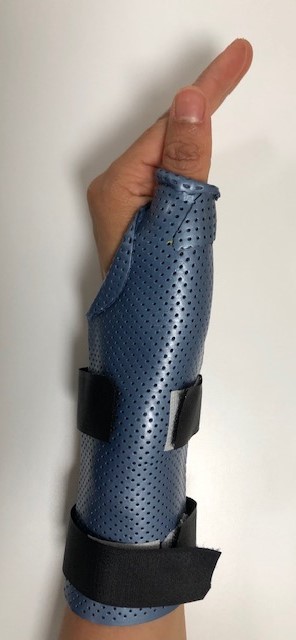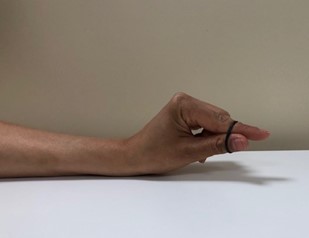Information for patients
This leaflet can be made available in other formats including large print, CD and Braille and in languages other than English, upon request.
What is De Quervain’s Tenosynovitis?
De Quervain’s Tenosynovitis is the term used to describe inflammation of two tendons that sit at the base of your thumb and wrist.

What is the cause of De Quervain’s Tenosynovitis?
Although the exact cause of De Quervain’s is unknown, there may be some risk factors as:
- Overuse of wrist and hand, such as increase or change in your activity, for instance DIY, gardening, new sport or job.
- Thumb injuries or strain.
- Inflammatory conditions.
- Hormonal changes associated with pregnancy.
What are the symptoms?
The symptoms include:
- Pain on the thumb side of the wrist.
- Pain that worsens with gripping, pinching or twisting movements.
- Tenderness if you press on the site of pain.
- Swelling may occur on this area.
- Clicking or snapping sensation of the tendons.
What is the treatment?
The majority of symptoms associated with De Quervain’s tenosynovitis will settle with rest and activity modification.
Things that you can do to help:
- Rest: Avoid aggravating movements or activities that increases pain.
- Ice: apply ice pack or a bag of frozen peas wrapped in a towel over painful area and leave on for 20 minutes every 4 hours. Check the skin and do not use if you have circulatory or peripheral nerve problems.
- Splint: wear a thumb/wrist splint off the shelf or custom made to allow symptoms to settle. The splint will need to be worn 24/7 for a minimum of 6 weeks
- Pain relief: speak with a pharmacist if you are unsure which medication may help.
- Hand therapy/physiotherapy: when symptoms are settling, you can start some exercises to regain range of motion, strength and function.
If symptoms fail to respond following six weeks of splinting, you may be offered:
- Steroid injection: to reduce pain and swelling.
- Surgery: surgical decompression of tendon sheath.
What if I have been referred to hand therapy?
Your hand therapist will provide you with a customised plastic splint.
This will support your thumb and wrist and will allow the pain to settle.
Your splint must be worn full time for 6 weeks.


How do I care for my splint?
- Wear your splint as advised by your therapist.
- Keep the splint clean and dry.
- DO NOT try to alter your splint.
- Keep away from sources of heat.
- You may clean the splint with baby wipes/a damp cloth.
Please be aware that wearing a splint continuously can cause irritation to the skin on your hand. If your skin becomes red, dry or blistered, or if you notice the splint rubbing or digging into your skin, please contact your Hand Therapist immediately.
What exercises can I do?
Following the splinting period, if your symptoms have significantly improved, your hand therapist will instruct you on an exercise programme.
Stage One
Complete the exercises 3 to 4 times a day.
Exercise 1: Assisted Thumb Extension
Sit up straight with arm resting on a table, palm down. Lift your thumb up towards the ceiling. Use the opposite hand to assist the thumb movement. Slowly and smoothly, allow your thumb to return to the starting position, unaided.
Repetition: x10 Hold: 5 to 10 seconds.


Exercise 2: Assisted Thumb Abduction
Sit up straight with you little finger resting on the table. Use your opposite hand to lift your thumb up and away from your index finger.
Slowly and smoothly, allow your thumb to return to the starting position, unaided.
Repetition: x10 Hold: 5 to 10 seconds.


Exercise 3: Assisted Wrist Deviation
Support your forearm on a table with your wrist on the edge and thumb pointing upwards. Slowly lower your wrist towards the floor until you start to feel a stretch felling or discomfort. Then use the other hand to bring the wrist to the start position.
Repetition: x10 Hold: 5 to 10 seconds.


Stage Two
Complete the exercises 3 to 4 times a day. Only progress to these exercises when Stage One exercises can be performed easily and without discomfort.
Exercise 4: Active Thumb Extension
Sit up straight with arm resting on a table, palm down.
Lift your thumb up towards the ceiling.
Hold: 5 to 10 seconds and then return to the starting position.


Exercise 5: Active Thumb Abduction
Sit up straight with you little finger resting on the table. Lift your thumb up and away from your index finger.
Hold: 5 to 10 seconds and then return to the starting position.


Stage Three
Your physiotherapist will advise you when you can progress to Stage Three. Complete the exercises 2 times a day.
Exercise 6: Isometric Wrist Hold
With your forearm and elbow supported on a table, wrist free (as picture). Hold a small weight/water bottle in this position, without any movement, for 20 to 40 seconds.
Repetition: x10 Hold: 20 to 40 seconds.

Exercise 7: Thumb Strengthening
Place a small elastic band around the outside of your thumb and index finger and pull these two fingers away from each other. Repeat with your thumb and the other fingers. To progress, repeat with a thicker elastic band.
Repetition: x10 Hold: 5 to 10 seconds.


Exercise 8: Resisted Wrist Deviation
With your forearm and elbow supported on a table, wrist free (as picture). Hold a small weight/water bottle and allow your wrist to drop downwards. Hold: 5 to10 seconds and then use your other hand to lift your hand back to the starting position
Repetition: x10 Hold: 5 to 10 seconds.


Contact Details
Please contact Hand Therapy if you have any concerns or questions, or if your splint is rubbing or is uncomfortable.
Contact details are:
North Tees and Hartlepool NHS Foundation Trust
Hand Therapy Team
Telephone: 01429 522471
Monday to Friday, 08:30 a.m. to 04:30 p.m.
You will be asked to attend either:
University Hospital of North Tees
Hand Therapy
1st Floor, North Wing
Hardwick Road
Stockton-On-Tees
TS19 8PE
University Hospital of Hartlepool
Physiotherapy Outpatients Department
Ground Floor
Holdforth Road
Hartlepool
TS24 9AH
References
- Cavaleri R, Schabrun SM, Te M, Chipchase LS. Hand therapy versus corticosteroid injections in the treatment of de Quervain’s disease: A systematic review and meta-analysis. J Hand Ther. 2016 Jan-Mar;29(1):3-11. doi: 10.1016/j.jht.2015.10.004. Epub 2015 Nov 6. PMID: 26705671.
- Goel R, Abzug JM. de Quervain’s tenosynovitis: a review of the rehabilitative options. Hand (N Y). 2015 Mar;10(1):1-5. doi: 10.1007/s11552-014-9649-3. PMID: 25762881; PMCID: PMC4349843.
- Allbrook V. ‘The side of my wrist hurts’: De Quervain’s tenosynovitis. Aust J Gen Pract. 2019 Nov;48(11):753-756. doi: 10.31128/AJGP-07-19-5018. PMID: 31722458
Comments, concerns, compliments or complaints
Patient Experience Team (PET)
We are continually trying to improve the services we provide. We want to know what we’re doing well or if there’s anything which we can improve, that’s why the Patient Experience Team (PET) is here to help. Our Team is here to try to resolve your concerns. The office is based at the University Hospital of North Tees if you wish to discuss concerns in person. Our contact details are:
Telephone: 01642 624719
Freephone: 0800 092 0084
Opening hours: Monday to Friday, 9:30am to 4:00pm
Email: [email protected]
Out of hours
Out of hours if you wish to speak to a senior member of Trust staff, please contact the hospital switchboard who will bleep the appropriate person.
Telephone: 01642 617617
Patient, Public and People with Lived Experience
We are looking for patients to share their experiences of healthcare and to join our Involvement Bank. Working with the patients, carers, families and the general population we support in making decisions about their care can lead to better health outcomes, increased patient satisfaction and a better overall experience. We want to listen and work with you in shaping the future of your healthcare services. To find out more about the Involvement Bank go to our website or contact us at:
Website: www.nth.nhs.uk/about/community/people-with-lived-experience
Email: [email protected]
Data protection and use of patient information
The Trust has developed Data Protection policies in accordance with Data Protection Legislation (UK General Data Protection Regulations and Data Protection Act 2018) and the Freedom of Information Act 2000. All of our staff respect these policies and confidentiality is adhered to at all times. If you require further information on how we process your information please see our Privacy Notices.
Telephone: 01642 383551
Email: [email protected]
Privacy NoticesLeaflet feedback
This leaflet has been produced in partnership with patients and carers. All patient leaflets are regularly reviewed, and any suggestions you have as to how it may be improved are extremely valuable. Please write to the Clinical Governance team at:
Email: [email protected]
Leaflet reference: PIL1520
Date for Review: July 2027